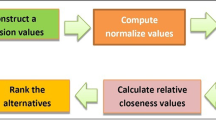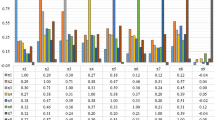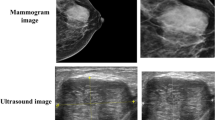Abstract
Efficient detection and classification of brain tumors using magnetic resonance images provide significant support to the neurologists. However, many approaches developed for this purpose exhibit limited accuracy due to irregular boundary pixels and intensity non-uniformity in MR images. Therefore, to minimize these issues and attain better performance, a new methodology is proposed based on the fuzzy thresholding and local texture feature descriptor. The proposed model includes four fundamental steps: noise reduction, tumor extraction, feature extraction, and classification. Anisotropic diffusion filtering is implemented to reduce the noise without losing information that is essential in the interpretation of the brain tumor images. Then, spatial fuzzy C-means thresholding and morphological operations-based image segmentation are applied to extract the tumor area of the brain. In the very next step, obtains texture features using a complete local binary pattern - based feature descriptor. These features capture inherent information from brain MR images. In the later stage, these features are concatenated using a serial-based fusion approach before classification using supervised learning approaches (decision tree, naive bayes, random forest, and LogitBoost). The above investigations are evaluated with simulations on harvard medical school and Kaggle repository data sets. The experimental outcomes support the significance of the proposed methodology which exhibited better performance compared to the state-of-the-art methods.















Similar content being viewed by others
Availability of data and material
All the data and materials are available with us for this research paper.
References
Louis DN, Ohgaki H, Wiestler OD, Cavenee WK, Burger PC, Jouvet A, Kleihues P (2007) The 2007 WHO classification of tumours of the central nervous system. Acta Neuropathol 114(2):97–109
Ostrom QT, Patil N, Cioffi G, Waite K, Kruchko C, Barnholtz-Sloan JS (2020) CBTRUS statistical report: Primary brain and other central nervous system tumors diagnosed in the United States in 2013–2017. Neuro-Oncology 22(Supplement_1):iv1–iv96
Liang ZP, Lauterbur PC (2000) Principles of magnetic resonance imaging: a signal processing perspective. SPIE Optical Engineering Press
Gordillo N, Montseny E, Sobrevilla P (2013) State of the art survey on MRI brain tumor segmentation. Magn Reson Imaging 31(8):1426–1438
Toğaçar M, Cömert Z, Ergen B (2020) Classification of brain MRI using hyper column technique with convolutional neural network and feature selection method. Expert Syst Appl 149:113274
Fayaz M et al (2016) (2016) A robust technique of brain MRI classification using color features and K-nearest neighbors algorithm. Int J Signal Process Image Process Pattern Recognit 9(10):11–20
Mohankumar S (2016) Analysis of different wavelets for brain image classification using support vector machine. Int J Adv Signal Image Sci 2(1):1–4
Khan MA et al (2019) Brain tumor detection and classification: a framework of marker-based watershed algorithm and multilevel priority features selection. Microscopy Res Techn 82(6):909–922
Mohsen H, et al (2017) Brain tumor type classification based on support vector machine in magnetic resonance images. Annals Of “Dunarea De Jos” University Of Galati, Mathematics, Physics, Theoretical mechanics, Fascicle II, Year IX (XL) 1
Dawud AM, Yurtkan K, Oztoprak H (2019) Application of deep learning in neuroradiology: brain haemorrhage classification using transfer learning. Computational Intelligence and Neuroscience
Çinar A, Yıldırım M (2020) Detection of tumors on brain MRI images using the hybrid convolutional neural network architecture. Med Hypothes 139:109684
Thejaswini P, Bhat MB, Prakash MK (2019) Detection and classification of tumour in brain MRI. Int J Eng Manufact (IJEM) 9(1):11–20
Jha D, et al. (2017) Pathological brain detection using weiner filtering, 2D-discrete wavelet transform, probabilistic PCA, and random subspace ensemble classifier. Comput Intell Neurosci
Selvapandian A, Manivannan K (2018) Performance analysis of meningioma brain tumor classifications based on gradient boosting classifier. Int J Imaging Syst Technol 28(4):295–301
Krishnammal PM, Raja SS (2020) Medical image segmentation using fast discrete curvelet transform and classification methods for MRI brain images. Multimedia Tools Appl 79(15):10099–10122
Toğaçar M, Ergen B, Cömert Z (2020) BrainMRNet: Brain tumor detection using magnetic resonance images with a novel convolutional neural network model. Med Hypotheses 134:109531
Gong S, Wei G, Francis A (2019) Brain tumor diagnosis based on artificial neural network and a chaos whale optimization algorithm. Comput Intell
Deepak S, Ameer PM (2019) Brain tumor classification using deep CNN features via transfer learning. Comput Biol Med 111:103345
Chaudhary A, Bhattacharjee V (2020) An efficient method for brain tumor detection and categorization using MRI images by K-means clustering & DWT. Int J Inf Technol 12(1):141–148
Bahadure NB, Ray AK, Thethi HP (2017) Image analysis for MRI based brain tumor detection and feature extraction using biologically inspired BWT and SVM. Int J Biomed Imaging
Vishnuvarthanan G et al (2016) An unsupervised learning method with a clustering approach for tumor identification and tissue segmentation in magnetic resonance brain images. Appl Soft Comput 38:190–212
Agrawal R, Sharma M, Singh BK (2019) Segmentation of brain tumour based on clustering technique: performance analysis. J Intell Syst 28(2):291–306
Vishnuvarthanan A, Rajasekaran MP, Govindaraj V, Zhang Y, Thiyagarajan A (2017) An automated hybrid approach using clustering and nature inspired optimization technique for improved tumor and tissue segmentation in magnetic resonance brain images. Appl Soft Comput 57:399–426
Pavan PS, Yepuganti K, Saladi S (2020) MRI brain tumor segmentation with slic and convolutional neural networks. J Crit Rev 7(19):4454–4462
Kulkarni A, Mukhopadhyay D (2017) SVM classifier based melanoma image classification. Res J Pharmacy Technol 10(12):4391–4392
Mittal M et al (2019) Deep learning based enhanced tumor segmentation approach for MR brain images. Appl Soft Comput 78:346–354
Nallasivan G (2021) An automated and improved brain tumor detection in magnetic resonance images. Turk J Comput Math Educ (TURCOMAT) 12(11):3370–3378
Ahmadi M, Sharifi A, Jafarian Fard M, Soleimani N (2021) Detection of brain lesion location in MRI images using convolutional neural network and robust PCA. Int J Neurosci 1–12
Assam M et al (2021) An efficient classification of MRI brain images. IEEE Access 9:33313–33322
Ventakasubbu P, Ramasubramanian P (2021) Deep learning-based brain tumour segmentation. IETE J Res 1–9
Ayane TH (2021) Brain tumor detection & classification using FRFCM segmentation and PSO based extreme machine learning and it’s implementation through embedded system. Turk J Comput Math Educ (TURCOMAT) 12(13):452–465
Singh R, Goel A, Raghuvanshi DK (2021) MR brain tumor classification employing ICA and kernel-based support vector machine. Signal Image Video Process 15(3):501–510
Bansal T, Jindal N (2022) An improved hybrid classification of brain tumor MRI images based on conglomeration feature extraction techniques. Neural Comput Appl 34(11):9069–9086
Raj SS, Abraham TS, Nirmala K (2022) Ensemble machine learning approach for brain tumor classification analysis. In 2022 First International Conference on Electrical, Electronics, Information and Communication Technologies (ICEEICT) (pp. 01–06). IEEE
https://www.kaggle.com/navoneel/brain-mri-images-for-brain-tumor-detection
Hoult DI, Lauterbur PC (1979) The sensitivity of the zeugmatographic experiment involving human samples. J Magn Resonanc 34(2):425–33
Manjón JV et al (2008) MRI denoising using non-local means. Med Image Anal 12(4):514–523
Gerig G et al (1992) Nonlinear anisotropic filtering of MRI data. IEEE Trans Med Imaging 11(2):221–232
Baozhong LIU, Jianbin LIU (2018) Overview of image noise reduction based on non-local mean algorithm. In: MATEC Web of Conferences. vol. 232. EDP Sciences
Bezdek JC, Ehrlich R, Full W (1984) FCM: the fuzzy c-means clustering algorithm. Comput Geosci 10(2–3):191–203
Chuang KS et al (2006) Fuzzy c-means clustering with spatial information for image segmentation. Comput Med Imag Gr 30(1):9–15
Lee SU, Chung SY, Park RH (1990) A comparative performance study of several global thresholding techniques for segmentation. Comput Vis Gr Image Process 52(2):171–190
Gonzalez RC et al (2010) Digital image processing using MATLAB. Tata McGraw-Hill, New York
Vincent L (1993) Morphological grayscale reconstruction in image analysis: applications and efficient algorithms. IEEE Trans Image Process 2(2):176–201
Humeau-Heurtier A (2019) Texture feature extraction methods: a survey. IEEE Access 7:8975–9000
Sastry SS, Mallika K, Rao BGS, Tiong HS, Lakshminarayana S (2012) Identification of phase transition temperatures by statistical image analysis. Liquid Cryst 39(6):695–700
Ojala T, Pietikäinen M, Harwood D (1996) A comparative study of texture measures with classification based on featured distributions. Pattern Recogn 29(1):51–59
Ojala T, Pietikainen M, Maenpaa T (2002) Multiresolution gray-scale and rotation invariant texture classification with local binary patterns. IEEE Trans Pattern Anal Mach Intell 24(7):971–987
Pietikäinen M, Ojala T, Zelin Xu (2000) Rotation-invariant texture classification using feature distributions. Pattern Recogn 33(1):43–52
Guo Z, Zhang L, Zhang D (2010) A completed modeling of local binary pattern operator for texture classification. IEEE Trans Image Process 19(6):1657–1663
Sharif M, Tanvir U, Munir EU, Khan MA, Yasmin M (2018) Brain tumor segmentation and classification by improved binomial thresholding and multi-features selection. J Ambient Intell Hum Comput, 1-20
Breiman L et al (1984) Classification and regression trees. CRC Press, Cambridge
Friedman J, Hastie T, Tibshirani R (2000) Additive logistic regression: a statistical view of boosting (with discussion and a rejoinder by the authors). Ann Stat 28(2):337–407
Zhao Y, Zhang Y (2008) Comparison of decision tree methods for finding active objects. Adv Space Res 41(12):1955–1959
Ng A, Jordan M (2001) On discriminative vs generative classifiers: a comparison of logistic regression and naive bayes. Adv Neural Inf Process Syst14
Liaw A, Wiener M (2002) Classification and regression by random Forest. R news 2(3):18–22
Reddy KR, Dhuli R (2022) Segmentation and classification of brain tumors from MRI images based on adaptive mechanisms and ELDP feature descriptor. Biomed Signal Process Control 76:103704
Acknowledgements
Not applicable.
Funding
No funding agencies for this research work. This work was carried out in the part of doctorate degree.
Author information
Authors and Affiliations
Contributions
K.R.R. contributed to conceptualization, methodology, software, formal analysis, investigation, validation, resources, and writing—original draft. R.D. contributed to supervision, review, and editing.
Corresponding author
Ethics declarations
Competing interests
The authors declare no competing interests.
Ethics approval and consent to participate
Not applicable.
Consent for publication
Not applicable.
Competing interest
The authors declare that they have no known competing financial interests or personal relationships that could have appeared to influence the work reported in this paper.
Additional information
Publisher's Note
Springer Nature remains neutral with regard to jurisdictional claims in published maps and institutional affiliations.
Rights and permissions
Springer Nature or its licensor (e.g. a society or other partner) holds exclusive rights to this article under a publishing agreement with the author(s) or other rightsholder(s); author self-archiving of the accepted manuscript version of this article is solely governed by the terms of such publishing agreement and applicable law.
About this article
Cite this article
Reddy, K.R., Dhuli, R. Detection of brain tumors from MR images using fuzzy thresholding and texture feature descriptor. J Supercomput 79, 9288–9319 (2023). https://doi.org/10.1007/s11227-022-05033-x
Accepted:
Published:
Issue Date:
DOI: https://doi.org/10.1007/s11227-022-05033-x




